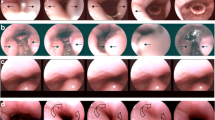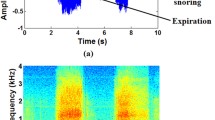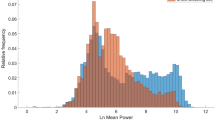Abstract
Despite several ways of investigation, such as clinical examination, drug-induced sleep endoscopy and pressure measurement of the upper airway, it is still difficult to locate the site of snoring exactly. Frequency analysis of snoring sounds is described as a promising diagnostic tool. The aim of the study was to examine simulated snoring under conditions awake, record the produced snoring sounds and compare those sounds with nocturnal snoring. A total of 50 snoring male patients were examined clinically by flexible nasal endoscopy and simulated snoring under conditions awake, and the simulated snoring sounds were recorded. Additionally, nocturnal snoring sounds were recorded during nighttime polysomnography. Snoring events were analyzed by fast-fourier-transformation and the intensity peaks 1–5 were evaluated. Rhythmic and non-rhythmic snoring events were distinguished depending on present obstructive apneas. Clinical and polysomnographical data were correlated with the results of the frequency analysis of the snoring sounds. Simulated snoring sounds revealed a low frequency of 200 Hz in intensity peaks 1 and 2 with an increase up to 3,000 Hz in peaks 3–5. Similar frequency patterns were detected in rhythmic nocturnal snoring. Non-rhythmic snoring events revealed frequency patterns between 2,000 and 3,000 Hz in all five intensity peaks. Simulated snoring resembles rhythmic nocturnal snoring with low-frequency intensity peaks, whereas non-rhythmic snoring revealed high frequencies. The examination during simulated snoring and frequency analysis of snoring sounds might contribute in locating the pathogenesis of snoring.











Similar content being viewed by others
References
AARC (1995) AARC-APT (American Association of Respiratory Care-Association of Polysomnography Technologists) clinical practice guideline. Polysomnogra Respir Care 40:1336–1343
Agrawal S, Stone P, McGuinness K, Morris J, Camilleri AE (2002) Sound frequency analysis and the site of snoring in natural and induced sleep. Clin Otolaryngol Allied Sci 27:162–166
Beck R, Odeh M, Oliven A, Gavriely N (1995) The acoustic properties of snores. Eur Respir J 8:2120–2128
Berry RB, Kouchi KG, Bower JL, Light RW (1995) Effect of upper airway anesthesia on obstructive sleep apnea. Am J Respir Crit Care Med 151:1857–1861
Bonora M, St John WM, Bledsoe TA (1985) Differential elevation by protriptyline and depression by diazepam of upper airway respiratory motor activity. Am Rev Respir Dis 131:41–45
Chadwick GA, Crowley P, Fitzgerald MX, O’Regan RG, McNicholas WT (1991) Obstructive sleep apnea following topical oropharyngeal anesthesia in loud snorers. Am Rev Respir Dis 143:810–813
Croft CB, Pringle M (1991) Sleep nasendoscopy: a technique of assessment in snoring and obstructive sleep apnoea. Clin Otolaryngol Allied Sci 16:504–509
Dalmasso F, Benedetto G, Pogolotti R, Righini G, Spagnolo R (1990) Digital processing of snoring sounds. Eur Respir J Suppl 11:528s–532 s
Deegan PC, Mulloy E, McNicholas WT (1995) Topical oropharyngeal anesthesia in patients with obstructive sleep apnea. Am J Respir Crit Care Med 151:1108–1112
Dolly FR, Block AJ (1982) Effect of flurazepam on sleep-disordered breathing and nocturnal oxygen desaturation in asymptomatic subjects. Am J Med 73:239–243
Dreher A, de la Chaux R, Klemens C, Werner R, Baker F, Barthlen G, Rasp G (2005) Correlation between otorhinolaryngologic evaluation and severity of obstructive sleep apnea syndrome in snorers. Arch Otolaryngol Head Neck Surg 131:95–98
Fernandez Julian E, Esparcia Navarro M, Garcia Callejo FJ, Orts Alborch MH, Morant Ventura A, de la Fuente L, Sanchez F, Marco Algarra J (2002) Clinical and functional analysis of long-term results of uvulopalatopharyngoplasty. Acta Otorrinolaringol Esp 53:269–280
Fiz JA, Abad J, Jane R, Riera M, Mananas MA, Caminal P, Rodenstein D, Morera J (1996) Acoustic analysis of snoring sound in patients with simple snoring and obstructive sleep apnoea. Eur Respir J 9:2365–2370
Hara H, Murakami N, Miyauchi Y, Yamashita H (2006) Acoustic analysis of snoring sounds by a multidimensional voice program. Laryngoscope 116:379–381
Hassid S, Afrapoli AH, Decaestecker C, Choufani G (2002) UPPP for snoring: long-term results and patient satisfaction. Acta Otorhinolaryngol Belg 56:157–162
Herzog M, Metz T, Schmidt A, Bremert T, Venohr B, Hosemann W, Kaftan H (2006) The prognostic value of simulated snoring in awake patients with suspected sleep-disordered breathing: introduction of a new technique of examination. Sleep 29:1456–1462
Hessel NS, Vries N (2004) Increase of the apnoea-hypopnoea index after uvulopalatopharyngoplasty: analysis of failure. Clin Otolaryngol Allied Sci 29:682–685
Hicklin LA, Tostevin P, Dasan S (2000) Retrospective survey of long-term results and patient satisfaction with uvulopalatopharyngoplasty for snoring. J Laryngol Otol 114:675–681
Hill PD, Lee BW, Osborne JE, Osman EZ (1999) Palatal snoring identified by acoustic crest factor analysis. Physiol Meas 20:167–174
McNicholas WT, Coffey M, McDonnell T, O’Regan R, Fitzgerald MX (1987) Upper airway obstruction during sleep in normal subjects after selective topical oropharyngeal anesthesia. Am Rev Respir Dis 135:1316–1319
Miyazaki S, Itasaka Y, Ishikawa K, Togawa K (1998) Acoustic analysis of snoring and the site of airway obstruction in sleep related respiratory disorders. Acta Otolaryngol Suppl 537:47–51
Petrou-Amerikanou C, Belazi MA, Daskalopoulou E, Vlachoyiannis E, Daniilidou NV, Papanayiotou PC (2005) Oral findings in patients with obstructive sleep apnea syndrome. Quintessence Int 36:293–298
Quinn SJ, Daly N, Ellis PD (1995) Observation of the mechanism of snoring using sleep nasendoscopy. Clin Otolaryngol Allied Sci 20:360–364
Quinn SJ, Huang L, Ellis PD, Williams JE (1996) The differentiation of snoring mechanisms using sound analysis. Clin Otolaryngol Allied Sci 21:119–123
Rombaux P, Bertrand B, Boudewyns A, Deron P, Goffart Y, Hassid S, Leysen J, Liistro G, Marien S, Moerman M, Remacle M (2002) Standard ENT clinical evaluation of the sleep-disordered breathing patient; a consensus report. Acta Otorhinolaryngol Belg 56:127–137
Steinhart H, Kuhn-Lohmann J, Gewalt K, Constantinidis J, Mertzlufft F, Iro H (2000) Upper airway collapsibility in habitual snorers and sleep apneics: evaluation with drug-induced sleep endoscopy. Acta Otolaryngol 120:990–994
White DP, Cadieux RJ, Lombard RM, Bixler EO, Kales A, Zwillich CW (1985) The effects of nasal anesthesia on breathing during sleep. Am Rev Respir Dis 132:972–975
Zonato AI, Bittencourt LR, Martinho FL, Junior JF, Gregorio LC, Tufik S (2003) Association of systematic head and neck physical examination with severity of obstructive sleep apnea-hypopnea syndrome. Laryngoscope 113:973–980
Author information
Authors and Affiliations
Corresponding author
Rights and permissions
About this article
Cite this article
Herzog, M., Schieb, E., Bremert, T. et al. Frequency analysis of snoring sounds during simulated and nocturnal snoring. Eur Arch Otorhinolaryngol 265, 1553–1562 (2008). https://doi.org/10.1007/s00405-008-0700-2
Received:
Accepted:
Published:
Issue Date:
DOI: https://doi.org/10.1007/s00405-008-0700-2




